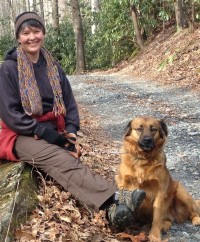When we were looking for land and a home where we could really settle down and create our next (hopefully last) beloved homestead we were seeking a very specific place. Despite the clear specs we relayed to real estate agents, you just would not believe the things they thought we’d love. But I was a frustrated farmer with a mission: find home.
When I am landless I get fairly desolate. Maybe this is genetic ptsd from my ancestry of Alabama sharecroppers. Unlike Mendy, who is somewhat relieved a landlord has to deal with upkeep, I grow melancholy quickly without dirt to call my very own. I become prone to get teary and slightly neurotic if I see a web photo of ET holding up that glowing finger and whispering “Home…” I’ve tried to use the time as practice on the transitory nature of life itself per Buddhist tradition and plant anyway. Mostly I fret in rental places.
So I went at the Great Farm Search of 2013 like General Patton turned back-to-the-lander. Somewhere I have the email that I obsessively sent out to every real-estate agent in the region. Of course I’d made a detailed list of the things we needed in a home and land, with specific bullet points for negotiable, non-negotiable and wish-list items. I did mention neurotic right?
There were several non-negotiables on the land section of the list: at least a couple of acres, some fairly level-ish ground in full sun (for a big garden), not a northern slope (read on), no ‘neighborhood association’ prohibitions on farmstead activities, not right on a busy major road, etc. If it had been just me I’d have added, Oh and a house too. Luckily Mendy made me give some guidelines there too. Ok, the house should have closets. We’ve lived in two houses, no kidding, that didn’t have a closet. So yes, I have standards! haha
But back to the important parts. Level-ish ground in full sun—and by that I mean land with actual soil on it and 6-8 of direct sunlight—is in short supply here in the mountains. Something like 3% of the land in this region is considered tillable. While that probably doesn’t’ count the little pocket gardens you’ll see in slivers of along creekbanks in most Appalachian hollers, you see the challenge we had.
Added to the topographical challenge was the fact our budget was extremely modest for this region beset with vacation homes of the well-heeled from all over. On that front we weren’t in competition at all. Besides being a galaxy away from our price range, vacation homes usually prioritize view and elevation and vertical floor plans. We wanted to be down lower—with the topsoil, year-round access, and a house that one could grow old in comfortably. That is to say, where most of the year-round locals live.
Southern exposure (meaning your site faces or opens southward…and the higher ridge is to your north) is a big deal here. The land is high, often closely spaced mountains running mostly on a north-south axis. It’s worth noting that “The word “Nantahala” is a Cherokee word meaning “Land of the Noonday Sun.” (Nantahala is a regional national forest with the classic high Appalachian topography.) “The name is appropriate as, in some spots, the sun only reaches the floors of the deep gorges of the national forest when directly overhead at midday.” [1]. Worse yet, a northern facing slope can be in full shadow for most of the winter since the sun is low in the sky. Not only does that ixnay growing winter gardens, it would likely ixnay my mental health.
So, given the explicit list of land requirements, why on earth did the real estate agents send over the particular listings they sent?
[to be continued]
—Five Apple Farm: Growing it Larrapin in the Blue Ridge of North Carolina. Posts may be boom or bust depending on the season. If you subscribe here you’ll get one weekly email with selected posts. You are also invited to get related miscellany wherever you like to ramble online: Facebook [brand new page…needs your “like”] | Twitter | Pinterest | Instagram.






